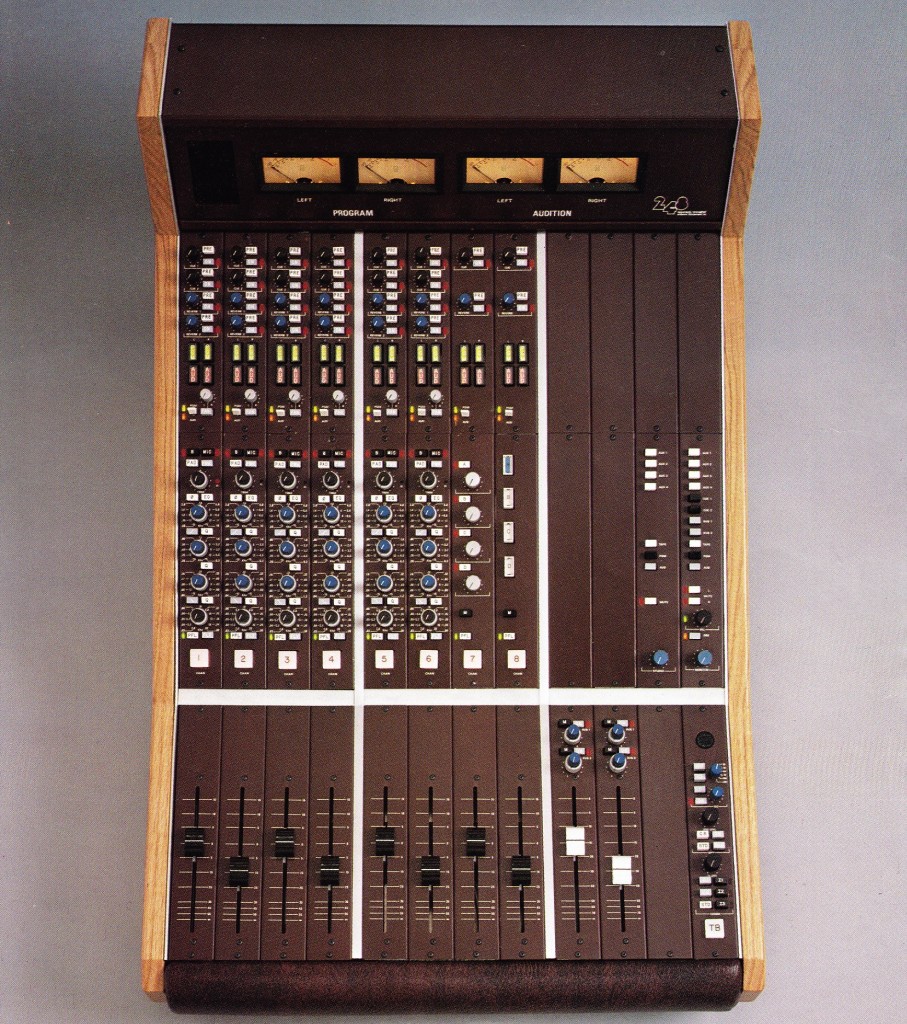 Download ten pages of literature regarding the Quad/Eight model 248 mixing system:
Download ten pages of literature regarding the Quad/Eight model 248 mixing system:
DOWNLOAD:QuadEight_248
Anyone?
 Download ten pages of literature regarding the Quad/Eight model 248 mixing system:
Download ten pages of literature regarding the Quad/Eight model 248 mixing system:
DOWNLOAD:QuadEight_248
Anyone?
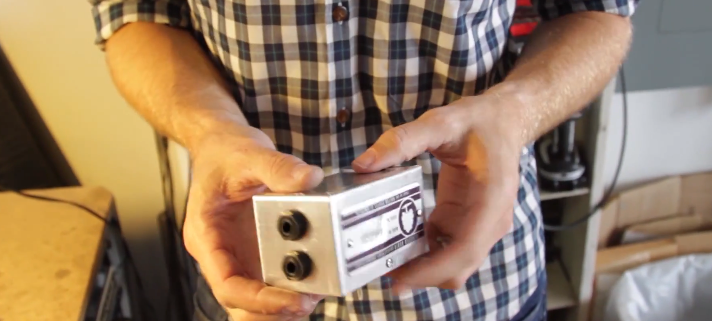 How are y’all doing today… we have a new video ready: “Build A Variable H-Pad.” If you’ve ever wanted an easy, controllable way of reducing level in the studio without losing signal balance or creating wild impedance variations (which can have undesirable consequences frequency-wise), this project is for you. I have a couple of these little boxes at Gold Coast Recorders and they get used pretty often; the most common use would be if I want to crank up a tube mic preamp to get some break-up on a drum kit or vocal mic. If this results in an excessive output level, I can just patch in one of these variable pads and dial in a safe level for the A/D convertors.
How are y’all doing today… we have a new video ready: “Build A Variable H-Pad.” If you’ve ever wanted an easy, controllable way of reducing level in the studio without losing signal balance or creating wild impedance variations (which can have undesirable consequences frequency-wise), this project is for you. I have a couple of these little boxes at Gold Coast Recorders and they get used pretty often; the most common use would be if I want to crank up a tube mic preamp to get some break-up on a drum kit or vocal mic. If this results in an excessive output level, I can just patch in one of these variable pads and dial in a safe level for the A/D convertors.
Check out the video, and here’s the schematic for anyone who wants to build one of these lil fellas. You’ll need two balanced jacks of your choosing, four 1% 1-watt 160-ohm resistors, one 200-ohm 1-watt resistor, a 1-watt 1-K linear taper pot, a terminal strip, and a small enclosure.
*******
***
For my original article which describes the development of this device, click here.
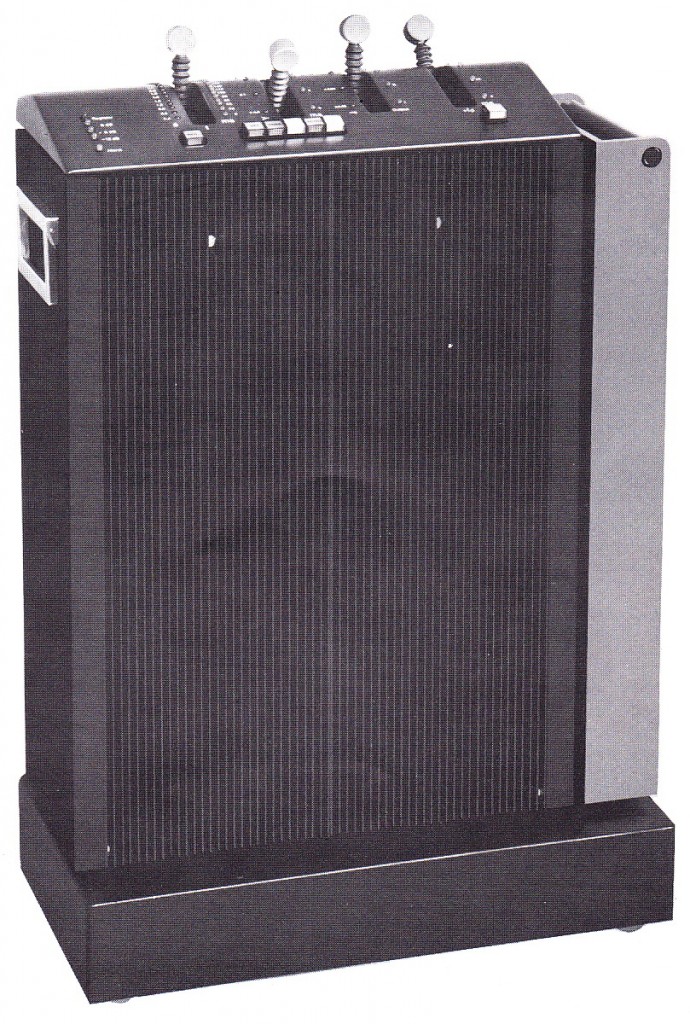 Download the original product-sheets for the EMT 250 Digital Reverb and its baby bro the 244:
Download the original product-sheets for the EMT 250 Digital Reverb and its baby bro the 244:
DOWNLOAD: EMT_244_250_reverb
That giant 99-lb star-wars-lookin thing above is an EMT 250. Ten years ago I was working on a session at Ocean Way Nashville and they still had one of these things right next to the console. Anyone out there still using a 250 in the studio? The 250 uses 12-bit, 24k convertors, which means that both input and output are low-passed at 11Khz.
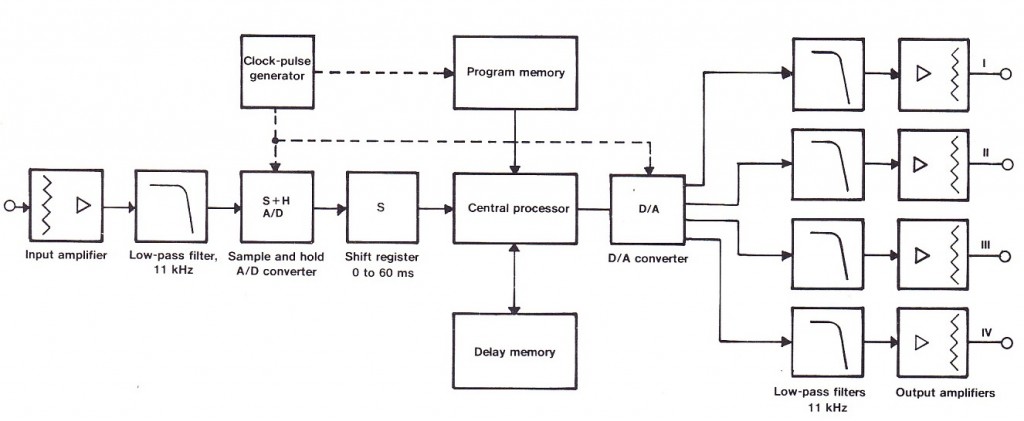 This brings up a good point about reverb in general: you don’t need a lot of hi-end to create good-sounding reverb for most applications… I always keep some sort of low-pass filter active in my reverb returns to trim off anything that’s not contributing in a meaningful way. Luckily, even the most basic reverb plug-ins tend to have a low-pass adjustment built in. My $0.02: use it!
This brings up a good point about reverb in general: you don’t need a lot of hi-end to create good-sounding reverb for most applications… I always keep some sort of low-pass filter active in my reverb returns to trim off anything that’s not contributing in a meaningful way. Luckily, even the most basic reverb plug-ins tend to have a low-pass adjustment built in. My $0.02: use it!
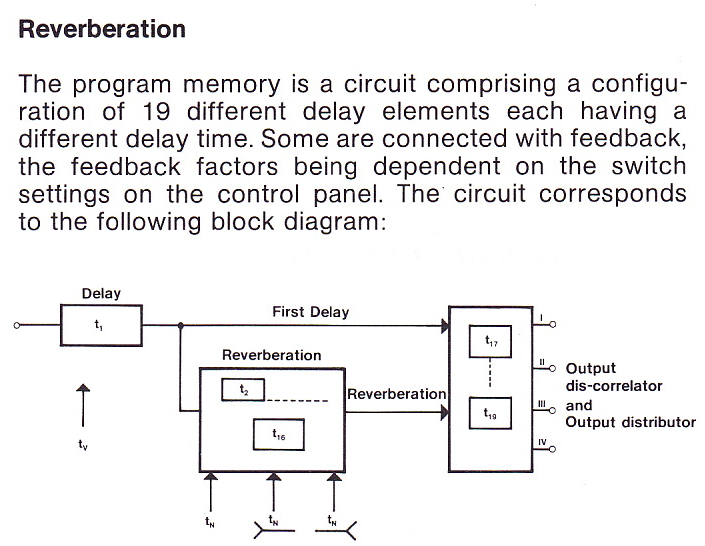 Very interesting to read this: so apparently the 250 uses 19 different taps, with feedback only on some of them.
Very interesting to read this: so apparently the 250 uses 19 different taps, with feedback only on some of them.
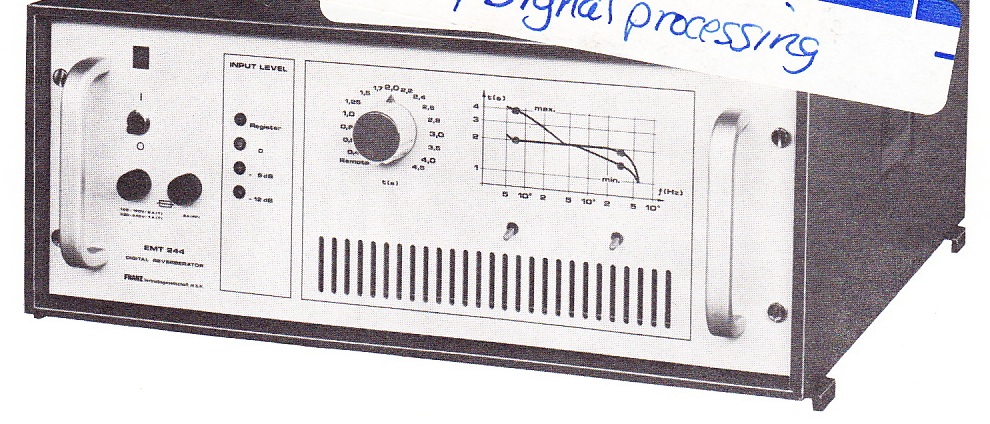 The lesser-known 244 (i’ve personally never seen one, FWIW) uses 13 bit convertors; no sampling rate is specified, but given that the frequency response is stated between 30hz and 8khz, it’s likely around 20k.
The lesser-known 244 (i’ve personally never seen one, FWIW) uses 13 bit convertors; no sampling rate is specified, but given that the frequency response is stated between 30hz and 8khz, it’s likely around 20k.
To you veteran engineers out there: was the 250 the first high-quality digital reverb? Were there any earlier units that you have used? Let us know,,,
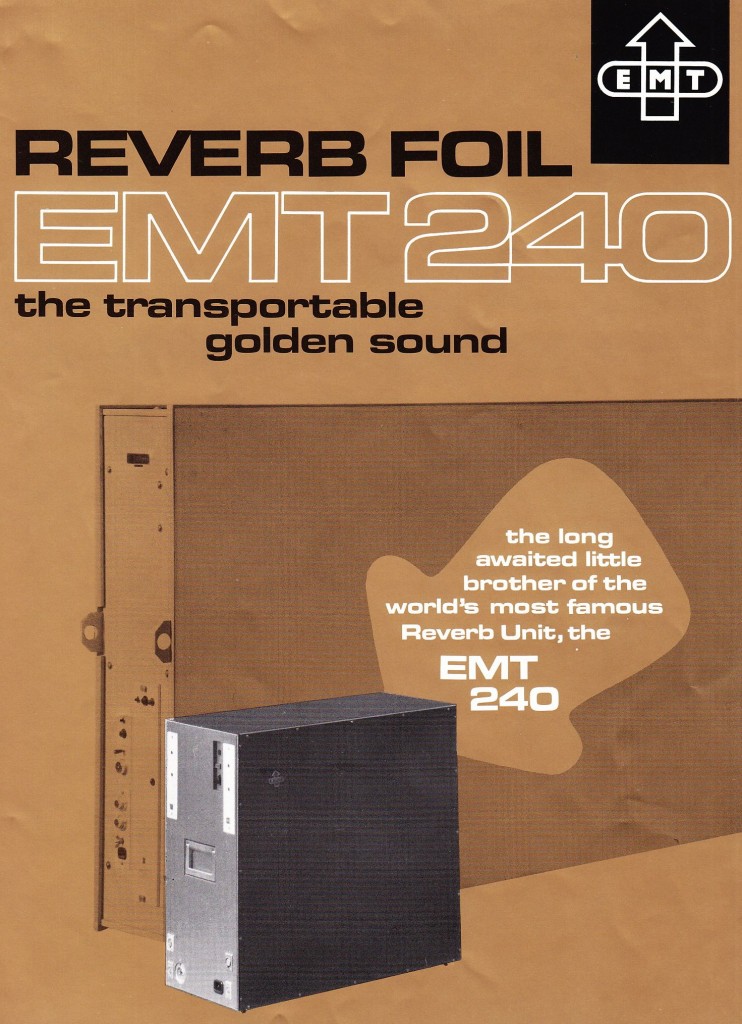 Download not one but two circa ’72 brochures for the EMT 240 ‘Gold Foil’ reverb system:
Download not one but two circa ’72 brochures for the EMT 240 ‘Gold Foil’ reverb system:
DOWNLOAD: EMT_240_reverb
The 240 was apparently intended not to replace the 140 so much as provide a smaller, portable (132 lbs haha) alternative. I’ve provided y’all with 10 pages of documentation here, it’s worth reading.. this thing really is an engineering marvel. Rather than a ‘plate,’ the reverberant surface is a tensioned sheet of gold-foil 18 microns thick. This gold-foil material, btw, was a completely in-house-made material… fkkn crazy. Anyhow, check it out… those of you who have had experience working with both a 140 and 240, pls weigh in on the relative merits thereof.
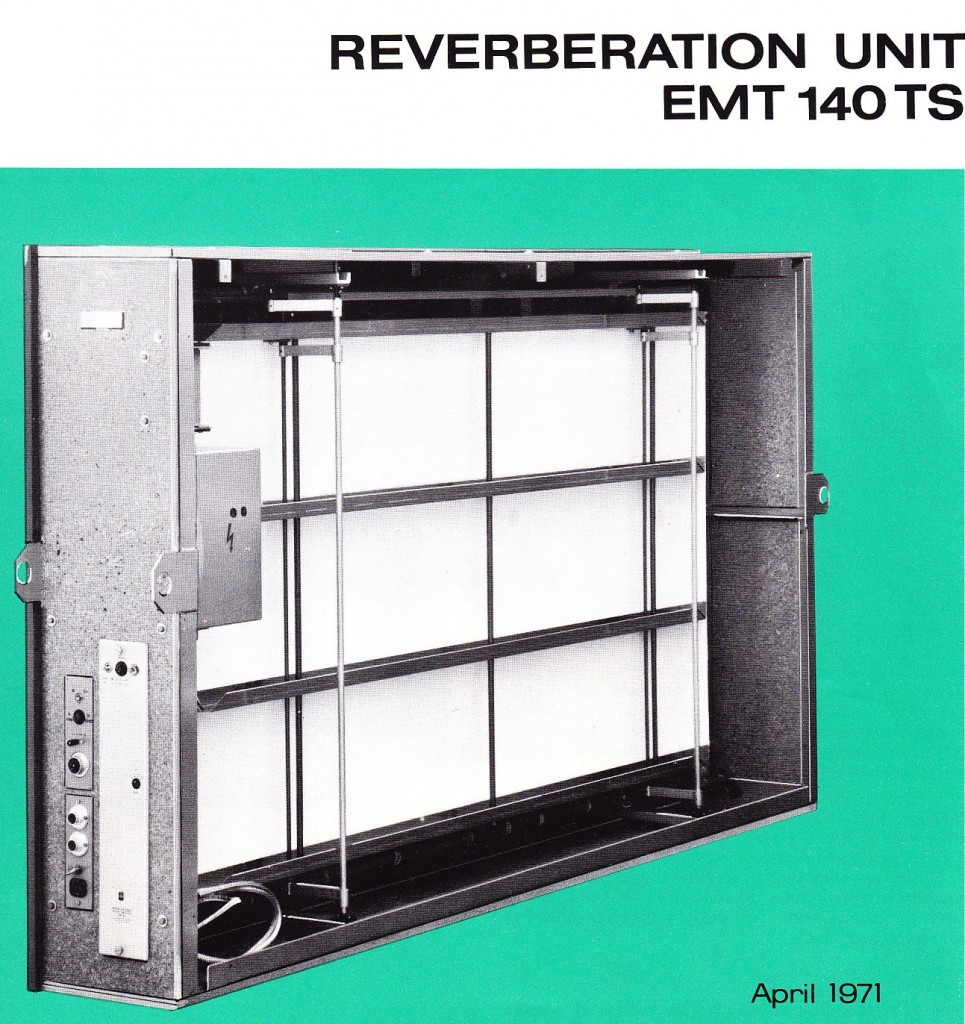 Got a pretty good one for y’all today… download the complete 8pp 1971 brochure for the EMT 140 TS reverb system:
Got a pretty good one for y’all today… download the complete 8pp 1971 brochure for the EMT 140 TS reverb system:
DOWNLOAD: EMT_140_ts_1971
I was recently given a large collection of 1970s EMT documentation, so get ready for detailed info on pretty much every EMT reverberation product ever made.
I met a studio owner recently, it was a very nice place, some excellent gear and instruments, mentioned that he was in the market for a plate; he felt that a good plate reverb is a piece of kit that can actually be a significant factor in a producer or engineer choosing one facility over another for a project. Those of you who regularly hire facilities for projects: agree? As a studio owner, I’ve personally been planning on skipping the plate and going directly to building a chamber, but who fkkn knows when/if this will happen. Plate would sure be nice… here’s what EMT had to say about the 140 back in ’71:
*******
***
For previous plate reverb coverage on PD dot com, click here…
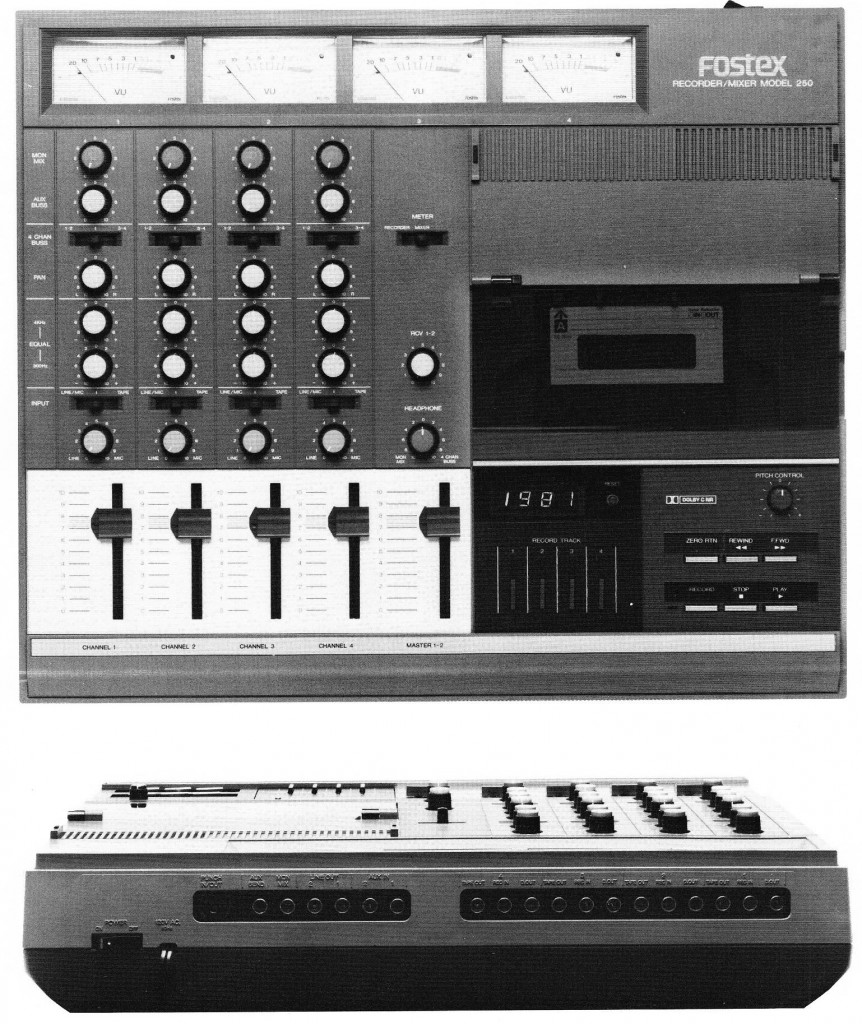 Download the complete 12pp Fostex “Creative Sound Systems” 1981 (???) catalog:
Download the complete 12pp Fostex “Creative Sound Systems” 1981 (???) catalog:
DOWNLOAD: Fostex_1981_Catalog
Models covered in great detail include: Fostex A-8, A-4, A-2 1/4″ tape machines; Fostex 250 cassette four-track; and the Fostex 350 8x4x2 mixer.
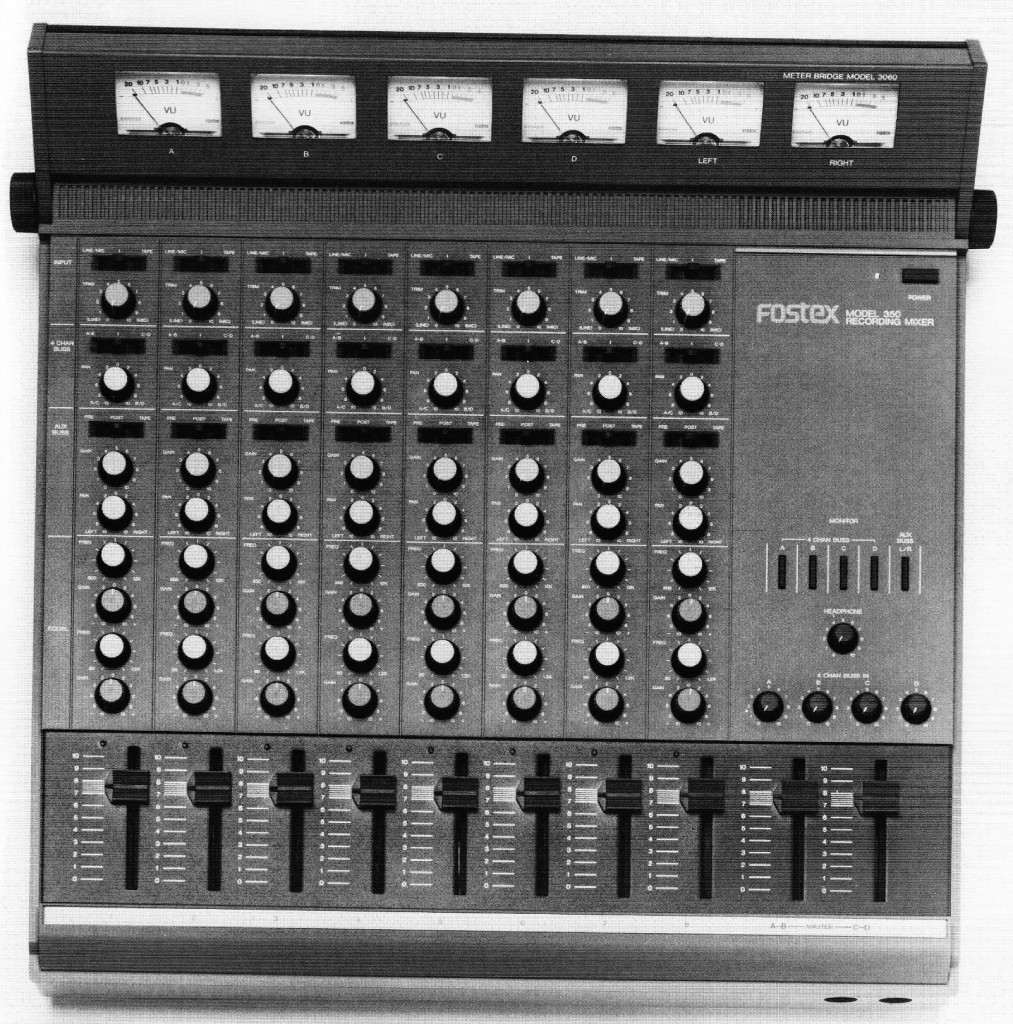 Interesting feature on the 350 – and something that’s not at all obvious from the top surface – it has 2 stereo RIAA phono preamps which are patchable on the rear of the unit, presumably to whichever inputs or external gear you like.
Interesting feature on the 350 – and something that’s not at all obvious from the top surface – it has 2 stereo RIAA phono preamps which are patchable on the rear of the unit, presumably to whichever inputs or external gear you like.
I’ve uploaded a ton of information on these machines before (see here, here, and here), so dig back if you want more commentary… otherwise i’ll let the catalog speak for itself…
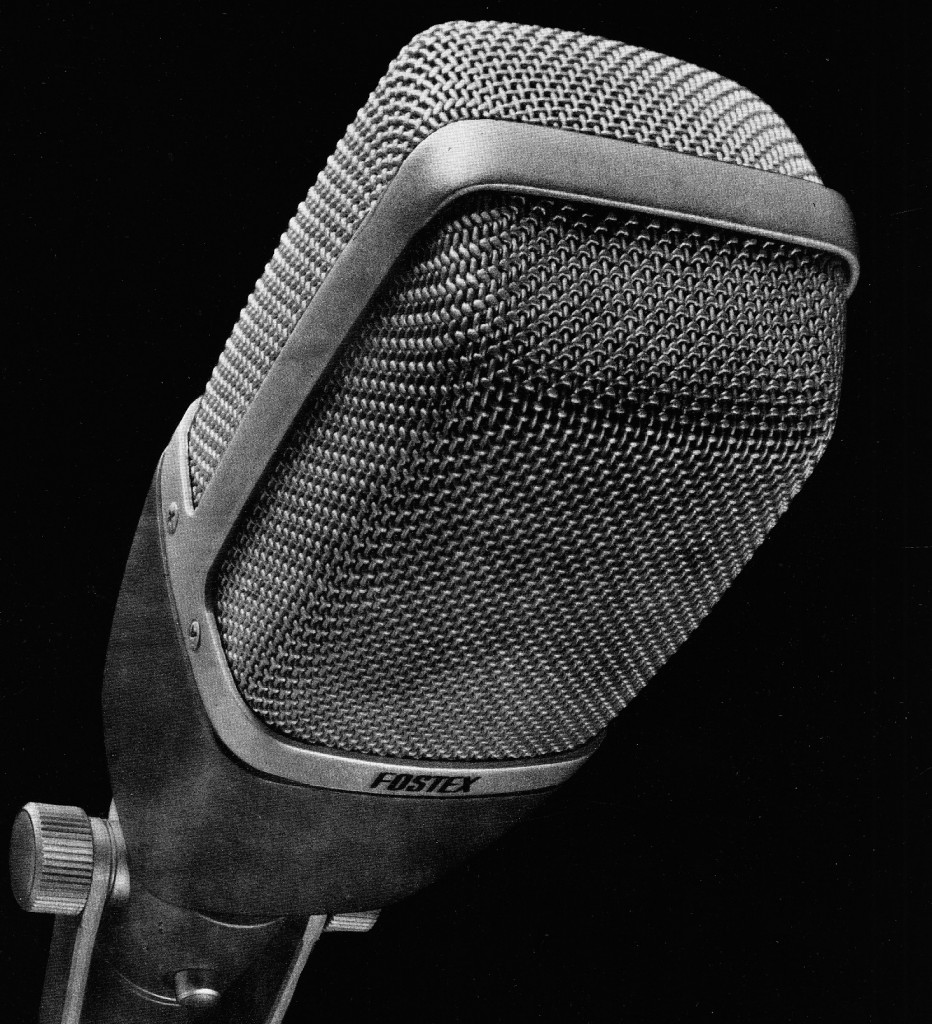 Download the 4pp 1980 catalog for the original Fostex “Regular Phase” microphone line:
Download the 4pp 1980 catalog for the original Fostex “Regular Phase” microphone line:
DOWNLOAD: fostex_mics_1980
Models covered, with text, specs, and photos, include: Fostex M85RP, M88RP, M80RP, M77RP, and M55RP.
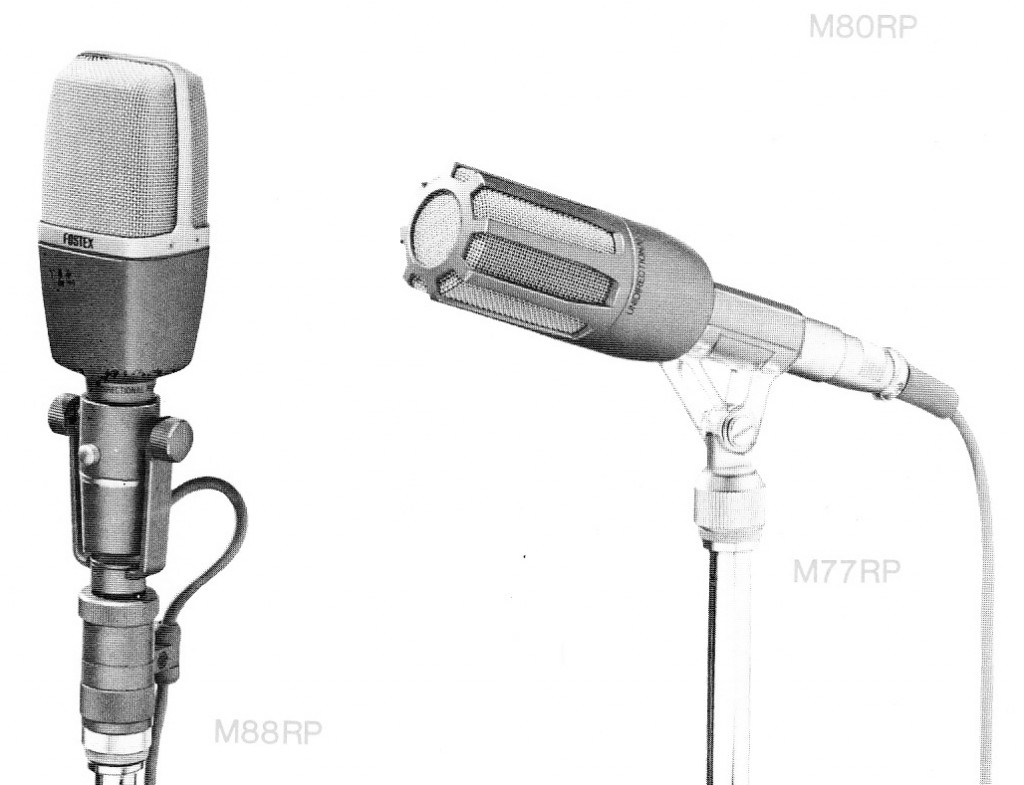 These mics, like the Fostex RP headphones, use a unique method of transduction that combines elements of dynamic, ribbon, and condenser-mic design. I’m not 100% sure why they are termed ‘regular phase,’ but I suspect that it might be because the design works without any driver suspension. You may not have realized before, but consider a generic woofer, and the acordian folds in the suspension: at any moment of driver excursion, portions of the suspension will necessarily be moving out-of-phase with the cone. This is a significant cause of transducer distortion. By eliminating the suspension, that particular distortion factor is eliminated. Here’s a cutaway of the Fostex design:
These mics, like the Fostex RP headphones, use a unique method of transduction that combines elements of dynamic, ribbon, and condenser-mic design. I’m not 100% sure why they are termed ‘regular phase,’ but I suspect that it might be because the design works without any driver suspension. You may not have realized before, but consider a generic woofer, and the acordian folds in the suspension: at any moment of driver excursion, portions of the suspension will necessarily be moving out-of-phase with the cone. This is a significant cause of transducer distortion. By eliminating the suspension, that particular distortion factor is eliminated. Here’s a cutaway of the Fostex design:
I’ve seen a few of these things on eBay from time to time, generally from ex-US sellers, and I’ve never seen one in the flesh, so I imagine that they are pretty rare in the US. The catalog that I’ve scanned above was actually printed in Canada, so I can’t even say for sure if these were sold in the US. I am super-curious, though, as I have always really loved the Fostex RP headphone line (I own a pair of T50, a pair of T40, and several pairs of T20s), and I’ve also had good luck with the classic Fostex full-range Banana Cone hi-fi drivers, so these mics seem like something I might dig. Anyone?
***************************************************************
I was recently at the excellent DOX center in Prague to see a mid-career retrospective of the Czech composer/artist Milan Gustar. Gustar could be described as a minimalist electronic composer. His pieces seem concerned with the perception of sound and with systems of describing, organizing, and controlling sound. One of the two pieces on display for actual playback (as opposed to simply a graphic score) was his TWIST; it was quite beautiful, and you can hear it here. Anyhow, Gustar’s work has unsurprisingly also taken him into the realm of research, and at the DOX I was able to purchase the two above-depicted hardbound Czech-language volumes, approx. 400pp and 500pp respectively. Although I can decipher very little of the text, these books are incredibly fascinating, with hundreds of photos and diagrams, and offer an extremely detailed account of the history of electro-mechanical instruments (vol. 1) and electronic instruments (vol. 2). You can read detailed descriptions of both books at these English-language links – VOLUME 1; VOLUME 2. As far as I know, no texts with this degree of detail exist in the English language. And remember, we always have Google Translate if you need to know roughly what’s being communicated – just type the Czech into the translation widget and cross yr fingers.
Anyhow, just a ton of stuff to dig into and use as a springboard for your own research and/or gear-hoarding activities. The books are quite affordable, approx. $30 US each, and you can purchase them by writing directly to the publisher at the email address here….
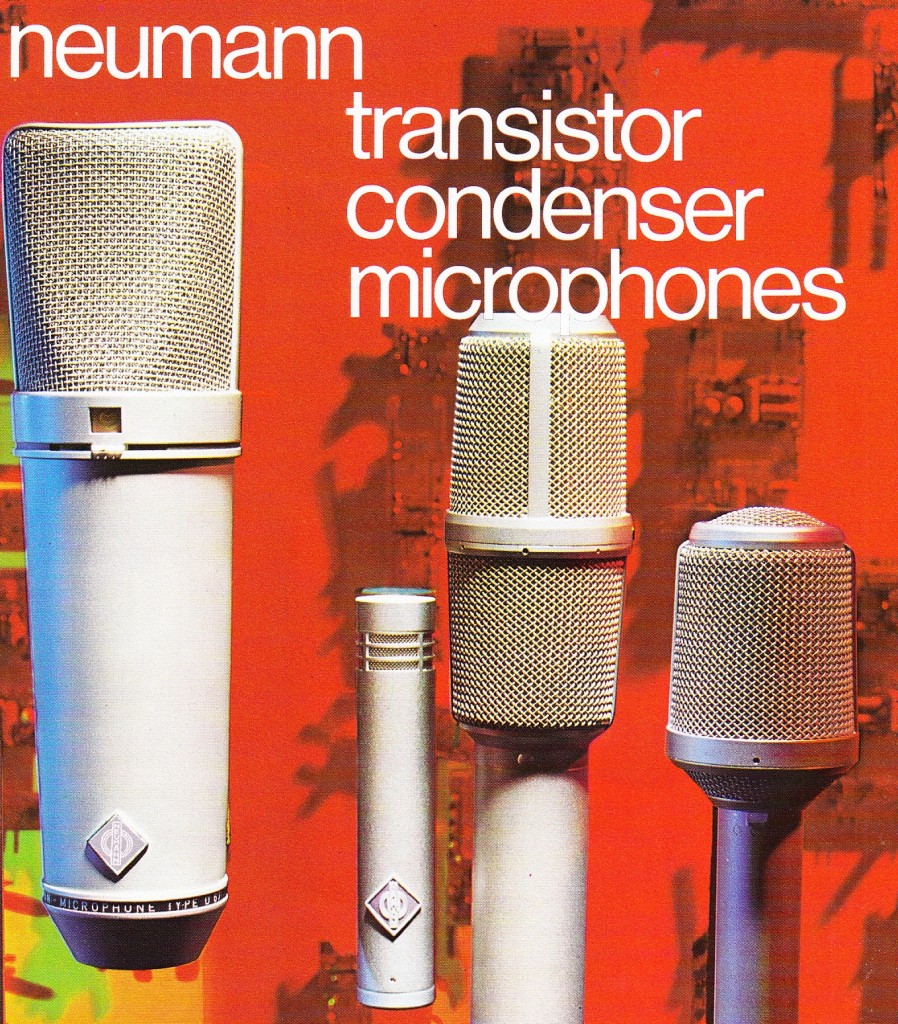 Download the 6pp 1973 Neumann FET 80 microphone catalog:
Download the 6pp 1973 Neumann FET 80 microphone catalog:
DOWNLOAD: Neumann_Fet80_1973
Models covered, with text, specs, and photos, include: Neumann KM 83, KM 84, KM 85, 87, and 88; KMS 85; U87, U47 FET, SM 69 FET, and KMA lav mic.
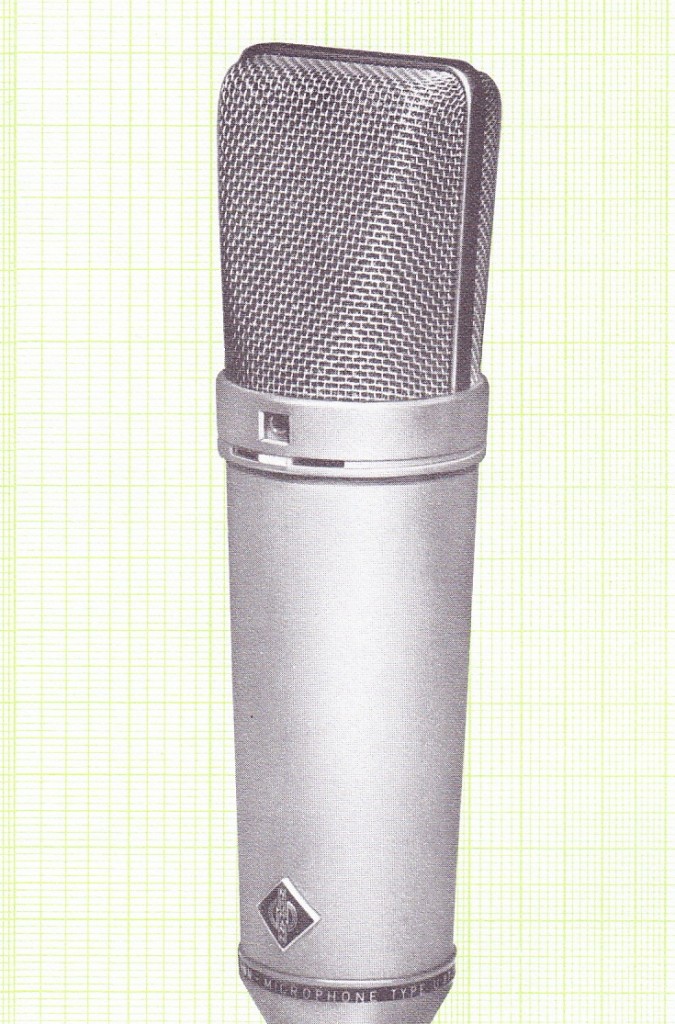 I have a U87 from this first era, and although it has its share of scars, it never fails to impress. Expensive but worth it… these things just WORK.
I have a U87 from this first era, and although it has its share of scars, it never fails to impress. Expensive but worth it… these things just WORK.
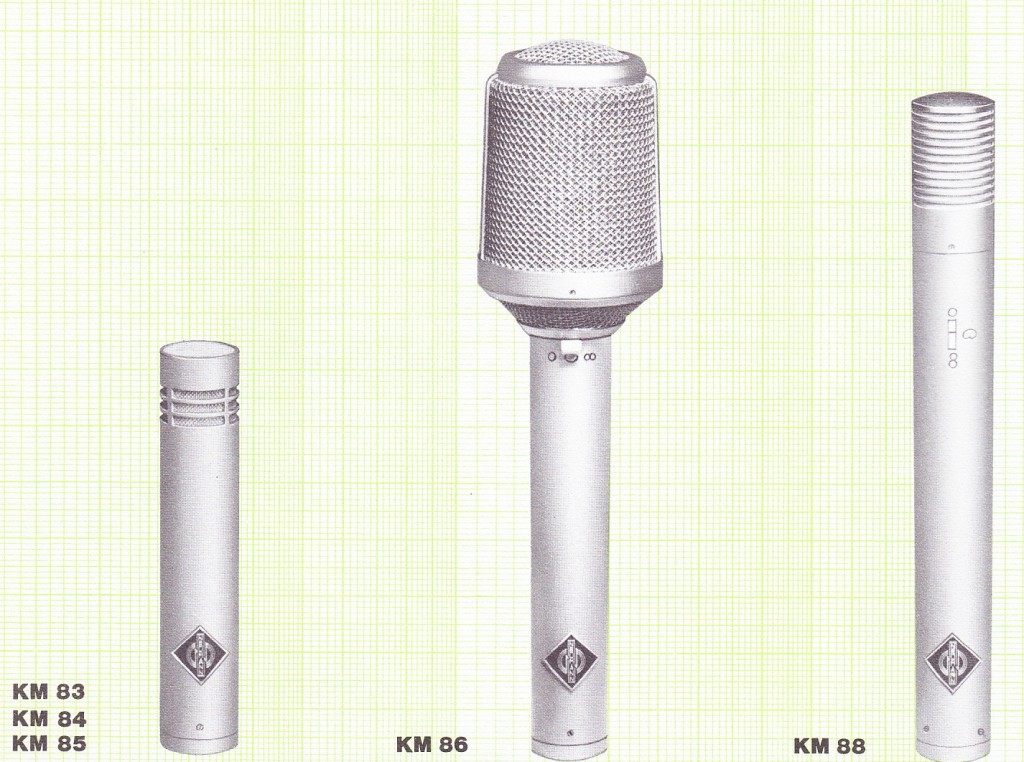 For our scan of the 1980 Neumann FET 80 catalog, click here…
For our scan of the 1980 Neumann FET 80 catalog, click here…
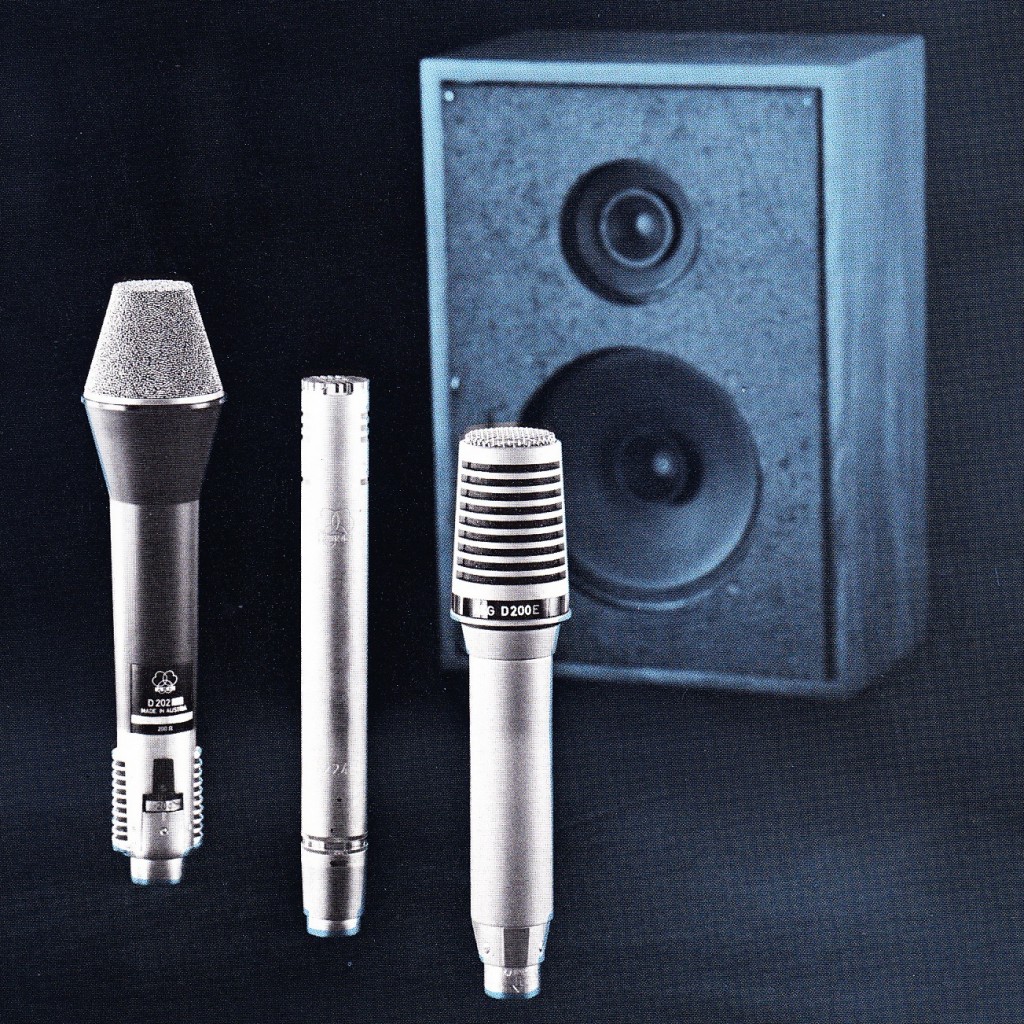 Download the 6pp 1970 catalog for AKG’s ‘Two-way” dynamic mics, the D-200E, D-202E, and D-224E:
Download the 6pp 1970 catalog for AKG’s ‘Two-way” dynamic mics, the D-200E, D-202E, and D-224E:
DOWNLOAD: AKG_2way_mic_1970
As the image above suggests, these operate exactly as you’d expect: there are separate ‘woofer’ and ‘tweeter’ elements, with a crossover at 500hz. Although the specs are quite good, i’ve never picked these up when I had the chance… just seems like they’ve gotta sound a little weird? Anyone? Anyone still using these? How do they compare to (x)?